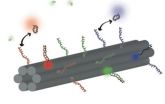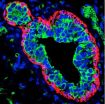(Press-News.org) What if you woke up every day to find that the closest grocery store had moved several miles farther away from your home? Over time, you would have to travel hundreds of extra miles to find essential food for yourself and your family. This is potentially a scenario faced by thousands of marine animals affected by climate change.
A new study published in Nature Climate Change examines the distribution of various open ocean animals in the North Pacific and explores how that could change over the next century as global ocean temperatures increase and productivity levels shift. The researchers conclude that some critical ocean habitats could undergo significant changes in location, moving more than 600 miles from where they are now, while other habitats could remain relatively unchanged.
Among large animals, loggerhead turtles, some sharks and blue whales may face the harshest impacts of climate change while some seabirds may actually benefit. Not only are species at risk, but also coastal communities and industries could feel the impact since top predator habitat shifts can result in the displacement of fisheries and ecotourism, such as whale watching.
"For species already stressed by overfishing or other human impacts, increased migration time and loss of habitat could be a heavy blow," said Elliott Hazen, a National Oceanic and Atmospheric Administration researcher on the project who is affiliated with the Center for Ocean Solutions at Stanford. "But if we can build some plausible scenarios of how marine ecosystems may change, this may help efforts to prioritize and proactively manage them."
In order to carry out their study, the authors employed complex mathematical models with data from the decade-long "Tagging of Pacific Predators" (TOPP) project, in which 4,300 electronic tags placed on 23 species from 2000 to 2009 created unprecedented insight into migration patterns and hotspots of predator species in the northern Pacific.
Satellite measurements of sea surface temperature and chlorophyll-a (used to estimate surface productivity) were combined with the tracking data to identify "key habitat areas" for a variety of different ocean predators. The researchers then used climate models of ocean temperature and productivity to ascertain how those key habitat areas might change in the face of ocean warming.
One of these key habitat areas, known as the North Pacific Transition Zone, marks the interface between cold, nutrient-rich polar water to the north and warmer, nutrient-poor water to the south. This region is used by a variety of ocean predators, including marine mammals, tunas and seabirds, as a corridor across the Pacific Ocean basin. The study suggests that this critical region could shift by as much as 600 miles, resulting in a 20 percent loss of species diversity in the region.
Other critical habitat areas, however, may experience little or no impact. The California Current, which runs along the west coast of North America, supports a variety of open ocean predators each year, when cold, nutrient-rich water creates regions of high productivity. This so-called upwelling cycle would likely continue despite ocean warming. "The fact that tagging indicates this is the number one lunch stop in town along the most populous coast in the nation – and stabilizes in a warming world – increases our opportunity to consider how to protect these hot spots," said Barbara Block, the Charles and Elizabeth Prothro Professor in Marine Sciences at Stanford, who is heavily involved in TOPP.
Among the Pacific's top predators, turtles, sharks and marine mammals such as whales appear to be most at risk from habitat shifts associated with Pacific warming. In some cases, predicted losses in essential habitat ranged as high as 35 percent.
But animals such as seabirds and tunas may benefit from climate-change-related shifts that could actually increase their potential habitat for foraging due to their broader tolerances to temperature.
"The differences from one species to another is their ability to adapt to temperatures and to use multiple ocean areas," said Hazen. "Having multiple sources of food, migration corridors and areas to call home provides a buffer against climate variability and change."
"Modeling of future scenarios is used in national security, financial investing and other critical areas," said Larry Crowder, the science director of the Center for Ocean Solutions, who was involved in the study.
"Here we use it to envision climate change impacts on large predators in the Pacific so that steps can be taken to better manage species that are important both commercially and for conservation goals," he said.
Based on these predictions, marine and coastal managers may alter fishing catches or revamp marine protected areas.
###The research was a collaboration including Salvador Jorgensen of Stanford's Hopkins Marine Station, Ryan Rykaczewski of the NOAA Geophysical Fluid Dynamics Laboratory and Steven Bograd of NOAA Southwest Fisheries Science Center.
The Center for Ocean Solutions is a collaboration among Stanford University's Woods Institute for the Environment and Hopkins Marine Station, the Monterey Bay Aquarium and the Monterey Bay Aquarium Research Institute.
Scientists predict major shifts in Pacific ecosystems by 2100
2012-09-24
ELSE PRESS RELEASES FROM THIS DATE:
Preterm birth of mother increases risk of pregnancy complications
2012-09-24
Women who were born preterm are at increased risk of complications during pregnancy compared to those born at term, and the risk almost doubles for mothers born before 32 weeks, according to a study in CMAJ (Canadian Medical Association Journal).
Pregnancy complications include gestational diabetes, gestational hypertension, and preeclampsia or eclampsia.
The findings are based on a study of 7405 women born preterm and 16 714 women born at term between 1976 and 1995 in the province of Quebec. Of the preterm women, 554 were less than 32 weeks at birth and 6851 were at ...
What does the feminization of family medicine mean?
2012-09-24
With more women in family medicine in Canada, what does this mean for the specialty and the profession, for patients and for society, asks a Salon opinion piece in CMAJ (Canadian Medical Association Journal).
Female family physicians (FPs) now outnumber males, with 50.6% of the profession now female; this trend will continue as older, mainly male, physicians retire. These changing demographics will have implications for the way medicine is practised and for patients. Female FPs practise differently than men, working fewer hours (47 v. 52), seeing fewer patients but with ...
Eunuchs outlive other men
2012-09-24
Castrated men living in Korea centuries ago outlived other men by a significant margin. The findings, reported in the September 25 issue of Current Biology, a Cell Press publication, suggest that male sex hormones are responsible for shortening the lives of men, the researchers say.
The evidence comes after careful study of genealogy records of noble members of the Imperial court of the Korean Chosun dynasty (AD 1392-1910).
"This discovery adds an important clue for understanding why there is a difference in the expected life span between men and women," said Kyung-Jin ...
JCI early table of contents for September 24, 2012
2012-09-24
Small proteins in the cornea protect against bacterial infection
Exposed tissue surfaces, including skin and mucous membranes, are under constant threat of attack by microorganisms in the environment. The layer of cells that line these areas, known as epithelial cells, are the first line of defense against these pathogens, but the underlying molecular mechanisms that allow them to repel microbes are unknown. In this issue of the Journal of Clinical Investigation, researchers at the University of California, Berkeley, report that epithelial cells in the cornea, which ...
Small proteins in the cornea protect against bacterial infection
2012-09-24
Exposed tissue surfaces, including skin and mucous membranes, are under constant threat of attack by microorganisms in the environment. The layer of cells that line these areas, known as epithelial cells, are the first line of defense against these pathogens, but the underlying molecular mechanisms that allow them to repel microbes are unknown. In this issue of the Journal of Clinical Investigation, researchers at the University of California, Berkeley, report that epithelial cells in the cornea, which is highly resistant to bacterial infection, express small antimicrobial ...
Human brains outpace chimp brains in the womb
2012-09-24
VIDEO:
This movie shows a pregnant chimpanzee undergoing an ultrasound imaging procedure to explore brain growth in her fetus.
Click here for more information.
Humans' superior brain size in comparison to their chimpanzee cousins traces all the way back to the womb. That's according to a study reported in the September 25 issue of Current Biology, a Cell Press publication, that is the first to track and compare brain growth in chimpanzee and human fetuses.
"Nobody knew ...
Pregnancy complications up to twice higher in women born preterm
2012-09-24
This press release is available in French. Women who were born premature are more likely to have pregnancy complications than women who weren't, according to data analyzed by a team lead by Dr. Anne Monique Nuyt, a neonatal specialist and researcher at the Sainte-Justine Mother and Child University Hospital Center and University of Montreal. This is the first study to clearly show the impact of preterm birth (i.e. before 37 weeks of gestation) itself on pregnancy risks. "We knew that to be born with a low birth weight could be associated with increased risk of pregnancy ...
Research shows ants share decision-making, lessen vulnerability to 'information overload'
2012-09-24
TEMPE, Ariz. – Scientists at Arizona State University have discovered that ants utilize a strategy to handle "information overload." Temnothorax rugatulus ants, commonly found living in rock crevices in the Southwest, place the burden of making complicated decisions on the backs of the entire colony, rather than on an individual ant.
In a study published in the early, online version of scientific journal Current Biology, Stephen Pratt, an associate professor in ASU's School of Life Sciences in the College of Liberal Arts and Sciences, and Takao Sasaki, a graduate student ...
Researchers at Harvard's Wyss Institute engineer novel DNA barcode
2012-09-24
VIDEO:
DNA origami is a process that can be used to self-assemble shapes that are of nanometer dimensions -- 100 nanometers is about 1,000 times shorter than the width of an...
Click here for more information.
BOSTON, September 24, 2012—Much like the checkout clerk uses a machine that scans the barcodes on packages to identify what customers bought at the store, scientists use powerful microscopes and their own kinds of barcodes to help them identify various parts of a cell, ...
Study uncovers mechanism by which tumor suppressor MIG6 triggers cell suicide
2012-09-24
New York, NY and Uppsala, Sweden, September 24, 2012 – Death plays a big role in keeping things alive. Consider the tightly orchestrated suicide of cells--a phenomenon essential to everything from shaping an embryo to keeping it free of cancer later in life. When cells refuse to die, and instead multiply uncontrollably, they become what we call tumors. An intricate circuitry of biochemical reactions inside cells coordinates their self-sacrifice. Tracing that circuitry is, naturally, an important part of cancer research.
In a major contribution to that effort Dr. Ingvar ...


